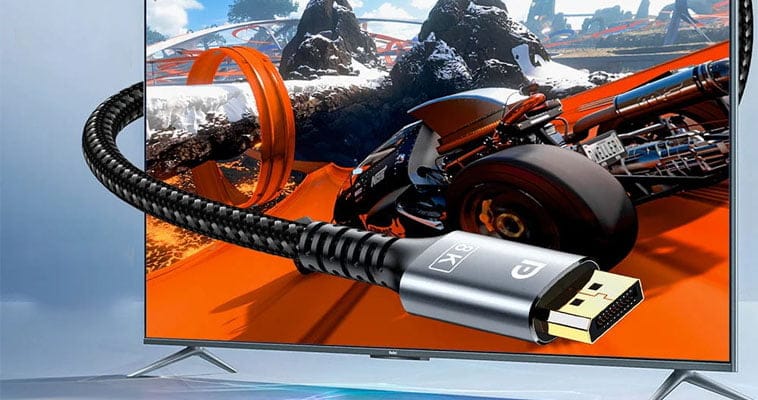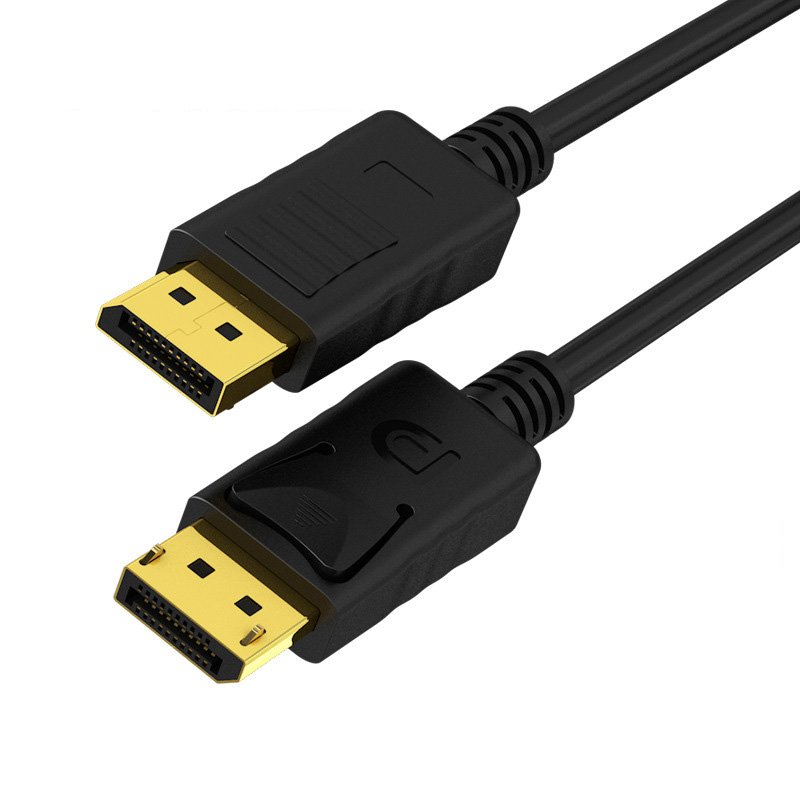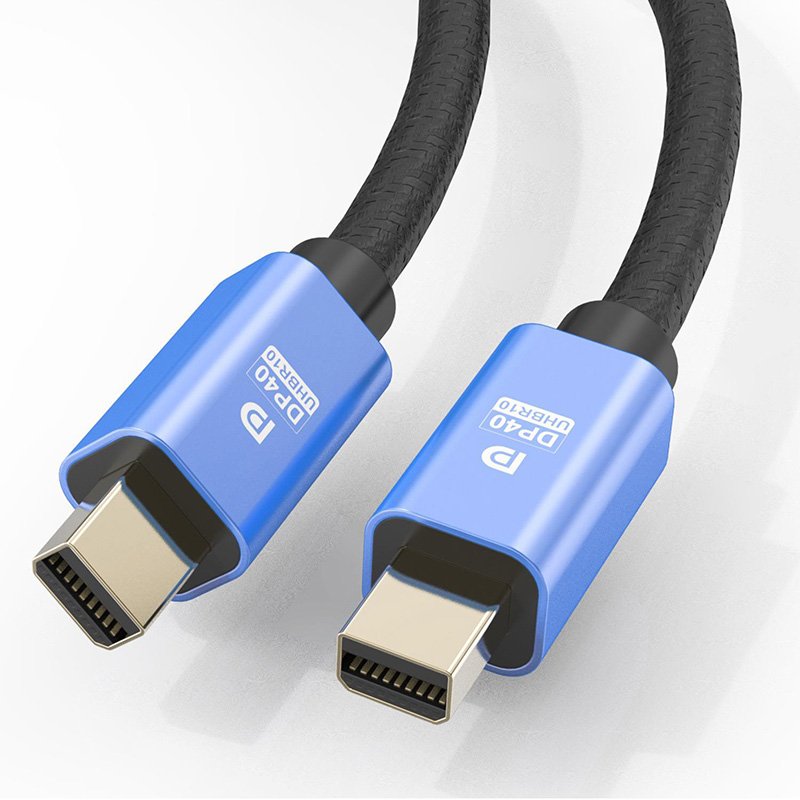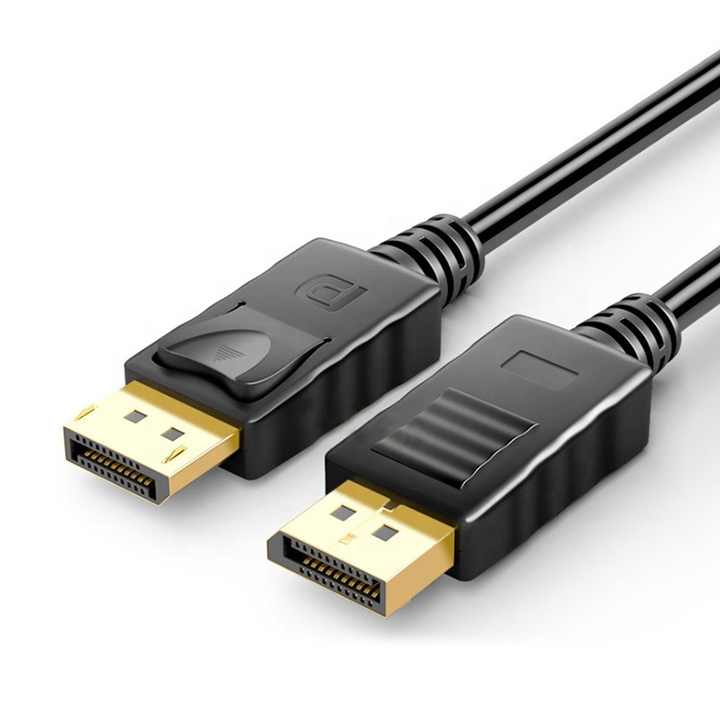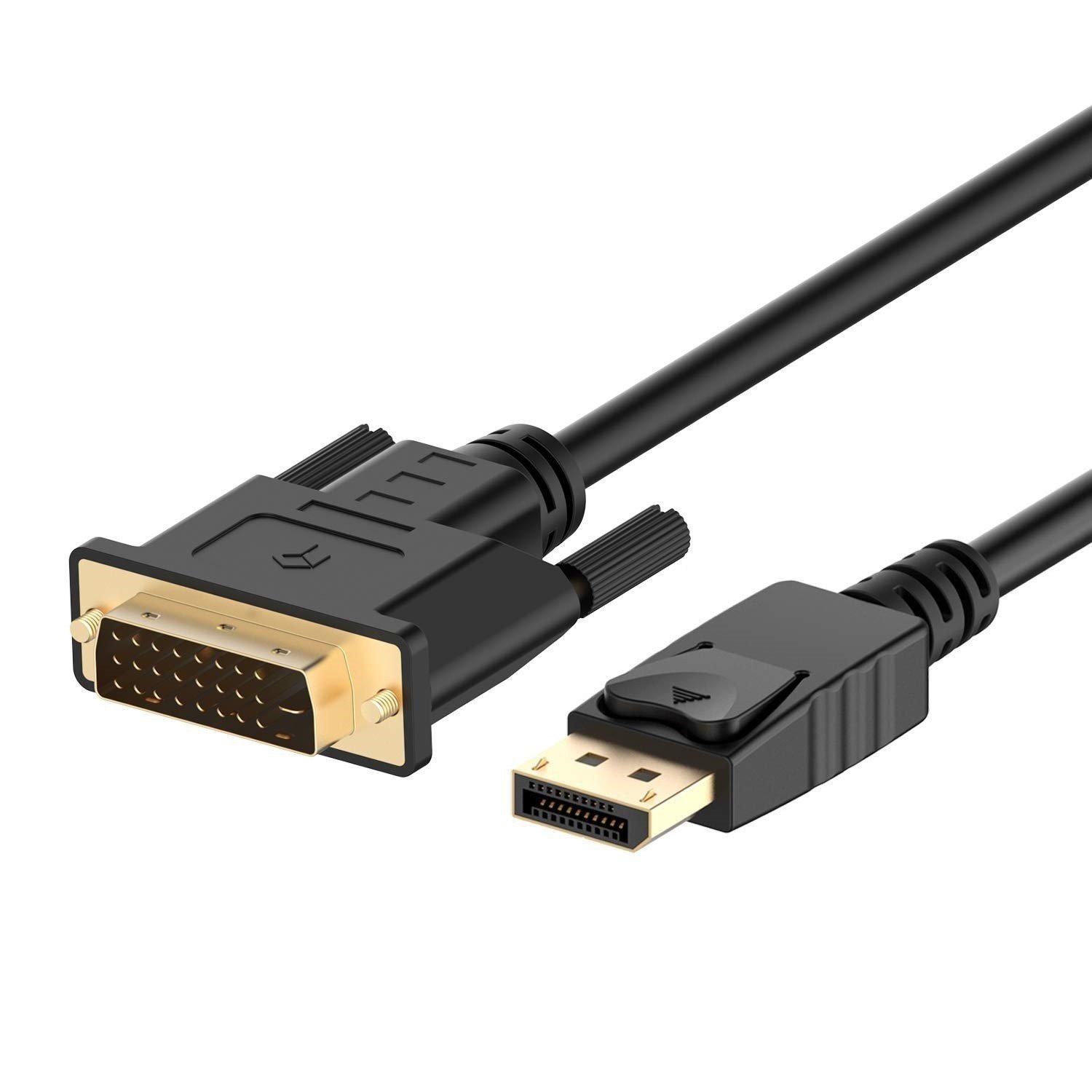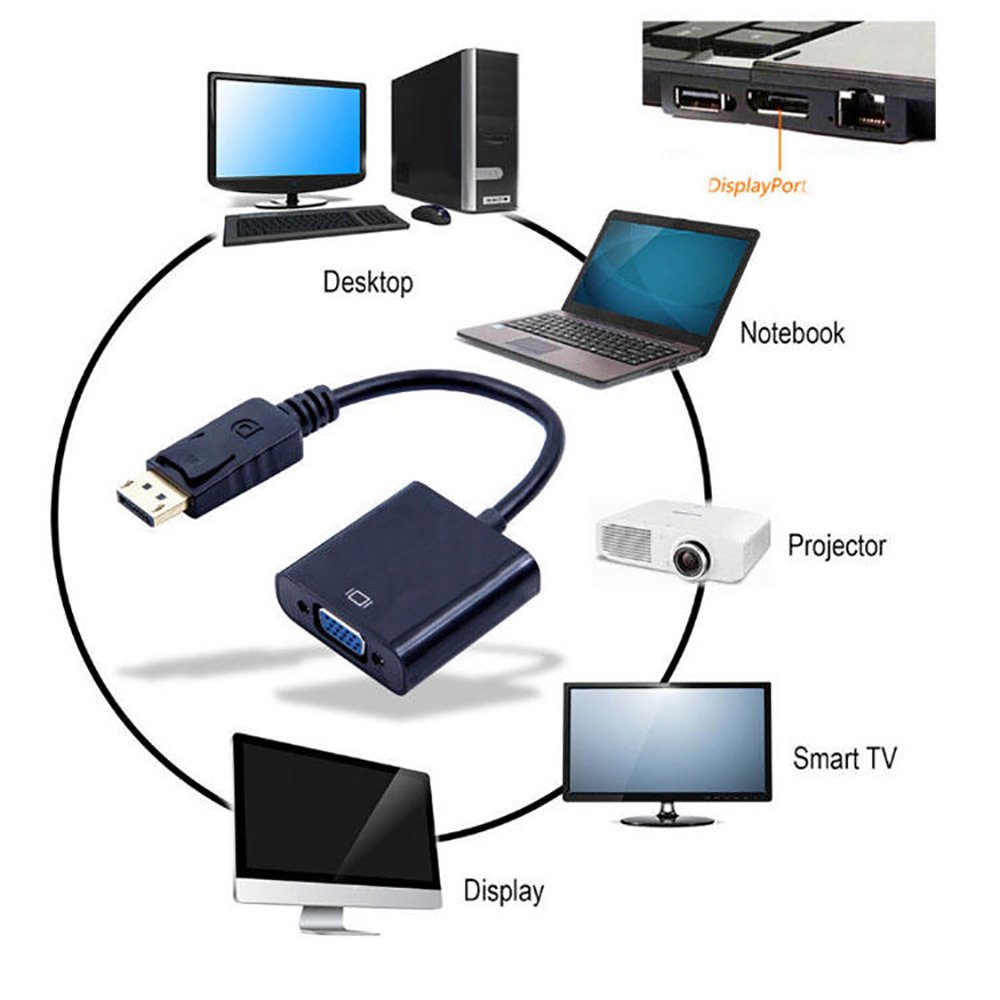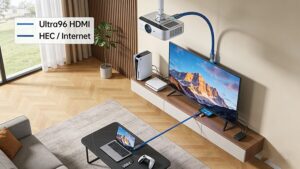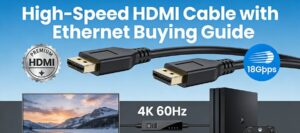With the rapid advancement of display technology, choosing the right cable to connect your devices has become increasingly important. In this comprehensive guide, we will explore everything you need to know about DisplayPort cables, from understanding the technology to selecting the best cable for your setup.
Introduction
It is a digital interface by VESA for high-quality audio and video output from devices like computers or consoles to displays such as monitors or TVs. Introduced in 2006, DisplayPort is popular for its versatility and high resolution support.
Types of DisplayPort Cables
Standard Cables
It are high-performance cables for transmitting audio and video signals, mainly used to connect computers and monitors, TVs, projectors and other devices. They support high resolution, high refresh rate and multi-channel audio, so they are widely used in professional and entertainment fields.
Main features:
- High bandwidth: The standard DisplayPort 1.2 version can provide up to 21.6 Gbit/s bandwidth and support 4K resolution (3840×2160) @60Hz display output.
- Multi-monitor support: Through daisy-chaining, users can connect multiple monitors with only one output line, thereby improving work efficiency.
- Audio transmission: Supports multi-channel audio transmission and can transmit high-quality audio signals.
- Variable refresh rate: If it supports Adaptive Sync technology, it can reduce screen tearing and improve the gaming and video experience.
- Compatibility: The DisplayPort interface is generally compatible with other video interfaces such as HDMI and DVI, and many devices can communicate with each other through adapters.
Use Cases:
- Professional Display: High-definition video production, CAD drawing, graphic design and other work scenarios with high image quality requirements.
- Gaming: High refresh rate monitors using DisplayPort can ensure a smooth gaming experience.
- Multi-screen setup: Suitable for users who need to expand the display area, such as traders and data analysts.
Mini DisplayPort Cables
It are high-bandwidth video and audio cables used to connect monitors and other display devices, and are widely used in devices that support high-resolution output.
Main features:
- Compact design: Mini DisplayPort is smaller than standard DisplayPort, suitable for ultra-thin laptops and portable devices.
- High-resolution support: Supports up to 8K resolution (7680×4320) and higher refresh rates, suitable for high-resolution display applications.
- Audio transmission: In addition to video transmission, Mini DisplayPort can also transmit multi-channel audio signals, simplifying the need for connecting cables.
- Strong adaptability: It can be converted to other interfaces such as HDMI, DVI or VGA through an adapter, which is convenient for compatibility with different devices.
Usage scenarios:
- Personal computers: Commonly used to connect high-resolution monitors, external displays, etc
- Video playback: Can be connected to high-definition projectors and TVs for video playback.
- Gaming devices: Gaming computers connect to high-refresh-rate gaming monitors via Mini DisplayPort.
DisplayPort to HDMI Cables
DisplayPort to HDMI cables are cables used to connect different video output devices (such as computers, game consoles or other display devices) with HDMI compatible monitors, TVs or projectors. They play an important role in modern digital display technology, allowing users to enjoy high-quality video and audio transmission.
Main features:
- Video Resolution Support: DisplayPort to HDMI cables typically support up to 4K resolution at 60Hz, ideal for gaming and high-definition video.
- Audio Transmission: These cables transmit video and multi-channel audio, catering to various user needs.
- Compatibility: DisplayPort is primarily for computer displays, while HDMI is common in TVs and entertainment devices, making it easy to connect different devices.
- Single Cable Solution: DisplayPort to HDMI cables combine audio and video, reducing clutter and offering convenience.
Usage scenarios:
- Office environment: Connect your laptop or desktop to an external monitor for multi-screen display and improve work efficiency.
- Home entertainment: Connect your game console or computer to a TV to enjoy a big-screen gaming experience or movie watching.
- Presentation: Use the big screen to show slides or videos in meetings or classes.
DisplayPort to DVI Cables
DisplayPort to DVI cables are conversion cables used to connect DisplayPort output devices (such as some graphics cards, laptops, etc.) to DVI input devices (such as monitors, projectors, etc.).
Main features:
- Compatibility: Supports conversion of DisplayPort signals to DVI signals, suitable for display devices without DisplayPort input.
- Video Quality: DVI supports high resolution, usually up to 1920×1080 (1080p) and above, suitable for most display needs.
- One-way transmission: The DisplayPort to DVI connection is one-way, allowing data transmission only from DisplayPort to DVI, with no reverse capability.
- No audio transmission: DVI only supports video signals, so this cable cannot transmit audio signals. If audio is required, an additional audio connection is required.
Usage scenarios:
- Old device upgrade: Older monitors or projectors usually use DVI interfaces. Use this type of cable to connect new hardware to old devices.
- Multiple monitor setup: When setting up multiple monitors, you can use this cable to connect different types of interface devices.
DisplayPort to VGA Cables
DisplayPort to VGA cables are adapter cables used to connect modern devices to traditional displays. cable converts signals for connecting devices with DisplayPort to VGA input devices.
Main features:
- Compatibility: Compatible with devices equipped with DisplayPort interfaces, including newer laptops and desktops, as well as older VGA monitors and projectors.
- Signal Conversion: DisplayPort is digital, and VGA is analog, so this cable often needs a built-in conversion chip for proper signal transmission.
- Resolution Support: DisplayPort to VGA cables support varying resolutions, typically up to 1920×1080 (1080p).
- Ease of Use: No extra drivers or software needed, just plug and play.
- Versatility: VGA is a long-standing standard for computer video output, ideal for older displays in schools and offices.
DisplayPort cable versions
| Versions | Function |
| DisplayPort 1.0 | The initial version supports a maximum resolution of 2560×1600 pixels and a maximum frame rate of 60Hz. |
| DisplayPort 1.1 | Added support for HDCP encryption and 5.1 channel PCM audio. |
| DisplayPort 1.2 | Added support for high-bandwidth data streams (HBR2), with a maximum resolution of 4096×2160 pixels and support for 4K displays. It also supports cascading multiple displays and bidirectional signal transmission. |
| DisplayPort 1.3 | It provides higher bandwidth and higher resolution support, with a maximum resolution of 7680×4320 pixels, supporting 8K displays. It also adds HDR support and variable refresh rate technology. |
| DisplayPort 1.4 | It further increases bandwidth and performance, supports a maximum resolution of 7680×4320 pixels and HDR, and introduces Display Stream Compression (DSC) technology, which can reduce transmission bandwidth without losing quality. |
| DisplayPort 2.0 | The latest version provides bidirectional 40Gbps bandwidth, supports a maximum resolution of 16K, and supports higher refresh rates and HDR technology. |
Pros and Cons of DisplayPort Cables
Pros of DisplayPort Cables:
- High bandwidth capacity: DisplayPort cables support high resolutions and refresh rates, making them ideal for gaming and professional use.
- Multi-monitor support: DisplayPort cables can easily support multiple monitors daisy-chained together, allowing for efficient workflows and increased productivity.
- Audio support: DisplayPort cables can transmit high-quality audio signals alongside video signals, eliminating the need for additional audio cables.
- Versatile connector: DisplayPort cables have a reversible connector for easy, orientation-free plugging.
Cons of DisplayPort Cables:
- Limited availability: DisplayPort cables are less commonly found in retail stores.
- Compatibility issues: Older devices may need adapters to use DisplayPort cables.
- Cost: DisplayPort cables tend to be pricier, especially for higher bandwidth or longer lengths.
- Limited device support: Some devices may not support DisplayPort cables, limiting your connection options.
FAQ
What is the difference between DisplayPort and HDMI?
DisplayPort is designed for high refresh rates and resolutions for computer displays, while HDMI is used for TVs and home entertainment, delivering audio and video together.
Can DisplayPort cables carry audio signals?
Yes, DisplayPort cables can carry audio signals.
How do I know if my device supports DisplayPort technology?
Check the specifications of your device to see if it mentions support for DisplayPort technology.

